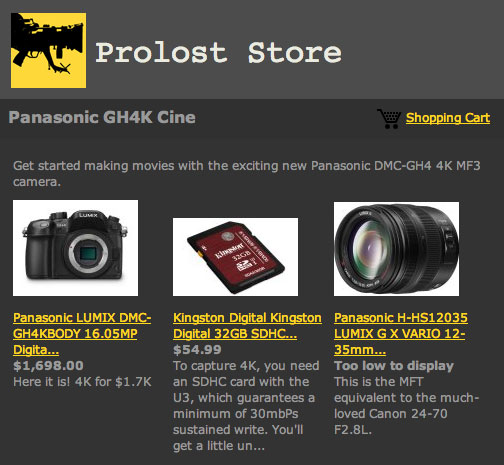OK guys, if you're serious about this...
 Monday, September 22, 2008 at 12:09AM
Monday, September 22, 2008 at 12:09AM 
From letsgodigital.org:
During a Panasonic Press event, at which the new Micro Four Thirds system was evaluated and further explained, Panasonic also revealed the development in process of a new Micro FourThirds system camera. Panasonic already claims that it will introduce the world's smallest High Definition system camera in 2009.
Apparently Panasonic is also a believer, touting an SLR-esque camera in which HD video is more than just an afterthought. Nice to see, considering that Panasonic's debut offering in this format has no video mode at all. The compact, mirorless Micro Four Thirds system is probably closer to the eventual collision of digital cinematography and stills systems than traditional DSLR designs are.
So, Panasonic, Nikon, Canon and anyone else who wants to dip their SLR chocolate into the HD peanut butter, here's what you need to do (and what Jim Jannard of RED already knows):
Everything that matters to a photographer matters to a filmmaker/videographer. The exact features that set a DSLR apart from a point-and-shoot put the "pro" in prosumer HD cameras. It basically boils down to quality and control, but here are a few more specifics to bear in mind—if you're serious:
- Adopt a known video standard that is compatible with current NLE software. A good one. But go big—consider a "visually lossless" codec.
- Use frame rates that make sense. 24 fps is great, 23.976 fps is better. Same with 30 and 29.97. Filmmakers often shoot funky frame rates for effect, anywhere between 1 and 72 fps. And sometimes much much more.
- No pixel binning or other dirty tricks for hurrying the data off the sensor—give us the best stuff your sensor is capable of. Capture the full resolution and downsample to video res. Or don't—1080p is not the top of the food chain, just ask RED.
- DSLRs eat and sleep raw. Consider a lightly-compressed DNG sequence output as an option. At the very least, offer RGB compressed video at a wide-gamut, minimum-processing color space. Let us turn down sharpening and other "enhancements" and record something that gives us room to play in post—just like we do with stills.
- Somehow we have to focus when shooting video. The screen on that Lumix G looks mighty big, but can I make critical focusing decisions with it? Maybe I could with focus assist features that are commonplace on HD camcorders.
- Jello-cam is not OK.
But more important than any of that: Give us control of our cameras—that same control that makes the SLR experience what it is. Video is not a "mode" on a dial that you select instead of manual control.When we're shooting video, we'd like to control the camera in the exact way we do when recording stills, not via some arcane menu.
The first one who gets this right changes everything.
UPDATE: Speaking of changing everything, read the comments below. Jim has scrapped the current Scarlet design and is starting fresh. What do you wanna bet it looks a bit more like the above?










